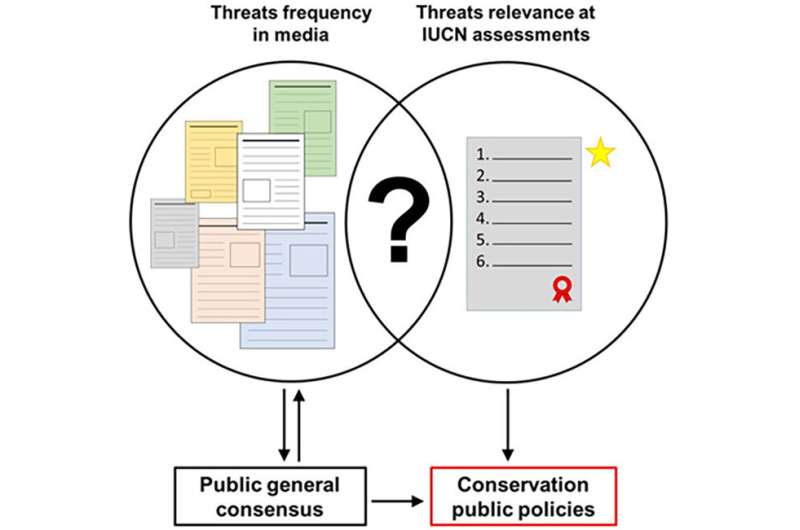Graphical abstract. Credit: Biological Conservation (2022). DOI: 10.1016/j.biocon.2022.109853
A group of researchers supported by FAPESP analyzed 192 news reports published on the internet between 2011 and 2021 on Brazilian deer species (Cervidae) in order to find out whether news of threats to these animals matched the actual risk of their extinction.
In an article on the study published in the journal Biological Conservation, the researchers conclude that news items located using the Google News search engine properly identified most threats to the eight deer species occurring in Brazil but ignored, underestimated or overestimated the threats to certain species.
The news gave different weights to some threats when juxtaposed with the Red List of Threatened Species maintained by the International Union for the Conservation of Nature (IUCN). The IUCN Red List is the most comprehensive inventory of the global conservation status of biological species. Furthermore, the news ignored the transmission of disease by domestic animals and low reproductive rates as factors affecting the survivability of deer species.
"We ranked the frequency of threats in news reports and developed a separate ranking of the threats listed by the IUCN. Part of the time, the news covered problems that coincided with the main threats determined as extinction risks by scientific studies. In other cases, however, reports overestimated threats such as roadkill and underestimated the effects of the transmission of livestock disease," said Rúbia Ferreira dos Santos Morini, first author of the article and currently a master's student at the State University of Campinas's Institute of Biology (IB-UNICAMP).
Threats
The authors compared three groups based on the animals' vulnerability to certain threats: all deer species together (Group A), species of the genus Mazama (Group B), and species of the genera Blastocerus, Ozotoceros, and Odocoileus (Group C).
Group B included the Red brocket deer (Mazama americana) and the Small red brocket deer (Mazama jucunda), which live in forests and are threatened by fragmentation of habitats such as the Atlantic Rainforest.
Group C included the Marsh deer (Blastocerus dichotomus), the Pampas deer (Ozotoceros bezoarticus) and the White-tailed deer (Odocoileus virginianus), all of which live in more open environments such as the Cerrado and Pantanal.
The researchers also constructed two threat frequency rankings, from 0 (none) to 6 (most frequent), based on the IUCN Red List and news items. They used statistical techniques to analyze the correlations between the rankings.
Correlations were high for Group A, where the main threats were poaching (illegal trafficking and killing of wildlife), habitat loss/fragmentation and attacks by dogs, but the news underestimated livestock diseases and overestimated road kill, stories about which are popular with the media, although this threat is less significant than low reproductive efficiency and population sustainability (deer have few annual offspring).
"When an animal is hit by a moving automotive vehicle, human beings are also at risk. That's probably the reason for so much media attention to road kill," said Márcio Leite de Oliveira, last author of the article.
The findings for Groups B and C were less positive. News reports correlated little with actual threats in the former case, and hardly at all in the latter, with only deaths due to canine attacks having matching importance.
Poaching and habitat loss are the first- and second-ranking threats respectively according to the IUCN, but in the news this order is inverted owing to the many reports of deer "invading" cities, alongside under-reporting of poaching and the difficulty of identifying hunted species when "deer meat" is found.
With regard to Group C, news reports on canine attacks, disease, road kill and low reproductive efficiency were similarly numerous, whereas dogs are the worst enemies of deer according to the IUCN. "In the case of this threat, which we termed predation by domestic dogs, there was a significant gap between the volume of news reports and the number of cases reported by official channels and scientific networks, possibly because there are no human witnesses to these attacks," Oliveira said.
There may also have been regional discrepancies, the authors note, since most of the news items analyzed came from Brazil's Southeast region, where population density is higher and there are more internet and smartphone users.
Common mistakes
The authors highlight the frequency of erroneous information in the news, noting that this can hinder education of the public about the importance of species conservation. Reports of people who find lone fawns, for example, tend to assume they have been abandoned by their mothers or are orphans, validating efforts to take deer into captivity. The scientific literature shows, however, that females often leave nestlings to forage and soon return with food.
The researchers also note that the many news reports on deer found in urban areas make little mention of the main reason, which is habitat loss due to expansion of cities and agriculture. "It's important for news items to cover the causes of the situations reported. Only then will readers understand the link between the presence of deer in urban areas and the degradation of nature, for example," Morini said.
Finally, lack of information on diseases that affect deer, such as bluetongue disease, caused by a virus transmitted by mosquitoes that bite sick cattle, contributes to the failure to isolate domestic animals from wildlife around agricultural areas and helps keep the virus in circulation.
"We hope our findings will underscore the importance of the media as a source of information on the threats to wildlife. We also hope they will lead both the media and the scientific community to work collaboratively toward conservation of these species," Oliveira said.
More information: Rúbia Ferreira dos Santos Morini et al, Do media reports reflect the real threats to wildlife?, Biological Conservation (2022). DOI: 10.1016/j.biocon.2022.109853
Journal information: Biological Conservation
Provided by FAPESP
























